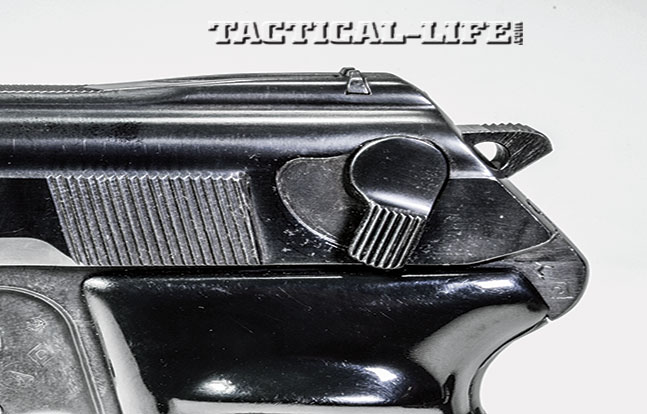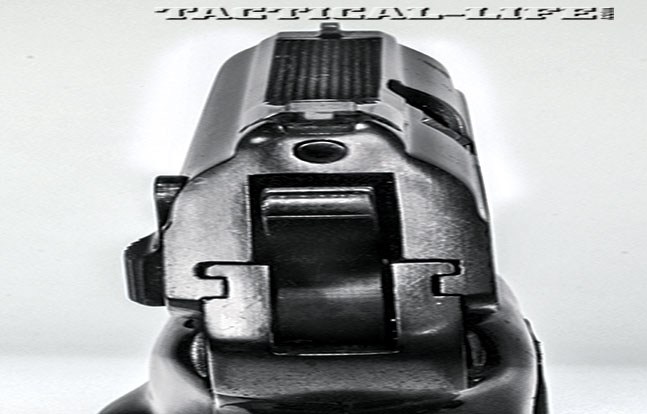As part of the “spoils of war” at the end of World War II, the Soviets took virtually all of the tooling from the Walther factory at Zella-Mehlis back to the Soviet Union, though some appears to have been used in East Germany for a time. The capture of the tooling and large numbers of Walther pistols during the war influenced the design of the Makarov pistol (by Nikolay Makarov) during the competition to replace the Tokarev TT-33. The greatest influence seems to have been the Walther Ultra, which was designed to take an intermediate round between the 9x17mm and 9x19mm. Many features of the Walther PP series were incorporated into the Makarov, and it was chambered for the 9x18mm Makarov round, which is similar to the 9x18mm Ultra round but not the same—the Makarov bullet is .365 and the Ultra bullet is .355. Also, the 9x18m Makarov case is longer and larger in diameter. Once the 9x18mm Makarov round became the standard service pistol load for the Soviet Union, within a few years other members of the Warsaw Pact adopted weapons in this chambering as well.
Some Soviet states, such as East Germany and Bulgaria, produced their own versions of the Makarov pistol, while others developed their own pistols chambered for the 9x18mm round. I became interested in these pistols years ago when I was working in places where I could sometimes acquire a 9x18mm pistol to carry. I often carried the pistol in a pocket, and one that I especially liked was the Polish P-64.
Developed in the late 1950s in response to a competition for a new service pistol by a team at the Polish Institute for Artillery Research, two versions of what would become the P-64 were developed. One was in 9x17mm (.380) caliber and one in 9x18mm Makarov caliber. The Model W, which was chambered for the 9x18mm round, had a longer barrel than the Model M chambered for the 9x17mm round. During the 1961 evaluation phase, however, the smaller Model M was selected but chambered in 9x18mm caliber. Designated the P-64, the pistol was produced at the Lucznik Arms Factory in Radom and entered service in 1965 as the 9mm pistolet wz. 1964. It replaced the Polish TT version of the Tokarev.
Advertisement — Continue Reading Below
In design and function, the P-64 is similar to the Walther PPK, though some internals are different and are covered by a Polish patent. It is a double-action (DA) blowback design with a hammer-drop safety. As with the PPK, it incorporates a loaded-chamber indicator, which may be seen or felt. It is larger in diameter than that of the PPK and, hence, easier to see or feel. When chambering a round, the safety lever may be placed in the down position, which will lock the firing pin and disconnect the trigger bar. I always liked this feature as it allowed a round to be safely chambered without having to lower the hammer manually on a loaded chamber. As with the PPK, the slide locks open after the last round is fired and may be released by pulling it backwards and releasing it after a reload is completed or after removing the empty magazine. A bottom magazine release, which catches a protrusion on the rear base of the magazine, is used. Since the magazine has a finger rest hook, by catching this hook and depressing the magazine release button, the mag may be removed readily.
As with a PPK, the P-64 disassembles by pulling down on the triggerguard and lifting the slide off the rear of the frame. I’ve learned from many years of using PPKs that the easiest method is to pull the front of the triggerguard down and then press it slightly to the left under the frame using the trigger finger while pulling the slide to the rear and off. There has been corrosive 9x18mm ammunition sold in the U.S. so with any ammunition about which you are unsure, a good cleaning with hot water and GI bore cleaner is advised. Fortunately, today most 9x18mm ammunition encountered is non-corrosive.
Drawbacks
Advertisement — Continue Reading Below
Since the magazine only holds six rounds, the grip of the P-64 is rather short. I have about medium-size hands, and I can barely fit three fingers over the grip plus finger rest. In fact, my little finger protrudes slightly over the finger rest. This raises one of my criticisms of the P-64. I like the fact it fires the more powerful 9x18mm round but in this pistol, recoil is definitely noticeable, especially since the hook of the finger rest cuts into my little finger when firing it. Once, when I was using a P-64 for a couple of weeks, I ground part of the plastic baseplate off to eliminate the finger rest. This allowed me to carry the P-64 in my pocket more readily and made it easier to shoot.
Another feature I do not like about the P-64 is its sights. Consisting of a tiny front blade and narrow rear notch, they are even more rudimentary than many PPKs I’ve used. During the Communist Era, the Poles remained surprisingly optimistic, as I have read that the sights were zeroed for 50 meters!
The final real negative feature of the P-64 is the heavy DA trigger pull. As with some other Warsaw Pact DA pistols, I believe there was intent here to make this an additional safety feature to prevent accidental/negligent discharges. I believe this is the heaviest DA pull I have encountered on a pistol—I’ve read from those who have measured it that it’s over 20 pounds, and I don’t doubt that. I have quite strong hands from years of exercising, and I have to exert substantial effort to pull the trigger. Any hopes of setting the trigger to get an accurate first round off are futile. Single-action (SA) pull, on the other hand, is mushy but relatively light. I think this is the only DA pistol I ever carried where I planned to cock it for the first round rather than using the DA. I understand from some who use the P-64 that if replacement hammer and recoil springs are obtained from Wolf Gunsprings, the DA pull will be improved and the recoil dampened to some extent. I have my P-64 as a reference pistol so I have kept it stock.
Advertisement — Continue Reading Below
Eventually, the P-64 was replaced by the 9x18mm P-83 Wanad, which has a larger grip and 8-round magazine capacity, among other features. As its designation indicates, it came into service in 1983, but was replaced around 2000, the Polish army having adopted the 9x19mm WIST-94 pistol in 1997 to conform to the standard NATO pistol round after Poland became a member.
Carrying Methods
As with most Warsaw Pact pistols—and most European police or military pistols in general—the P-64 holster is of the encasement type with one built-in pouch for a spare magazine. There were exceptions among police agencies that encountered a lot of crime or faced serious terrorist threats, which inspired them to go with open top-flap holsters that allowed a faster draw. Given that Polish troops or police carrying the P-64 most likely would already have it in their hand when anticipating a threat, this holster sufficed and kept the pistol protected from the elements. Maybe it’s because the holster with my P-64 is virtually new, but it takes some real effort to stretch the tongue that snaps the flap shut to close it or to pull it free to open it. Even with a DA most users probably carried the chamber empty, a total of 12 rounds (one mag in the gun and one in the holster mag pouch) on the streets of Warsaw would have seemed scant to me, but I’m from St. Louis; I carry a pistol and a spare magazine to take the garbage out! After consideration, carrying the P-64 chamber empty and racking the slide to chamber a round before engaging was probably advisable given the horrible DA trigger pull.
Advertisement — Continue Reading Below
Despite the fact that I am aware of problems with storing pistols or revolvers in their holsters, I usually oil up my pistols with this type of holster well and store them in the holster so I can keep holster, gun and spare magazine together. Of course, the safe I keep them is a humidity-controlled environment.
I’m pretty sure there was a shoulder holster available for the SB (Sluzba Bezpieczenstwa)—the Czech secret police—or for police investigators. In fact, I remember once when I was using a P-64, I had a shoulder rig that was of the cheap Eastern European style, but I don’t know if it was Polish issue.
Range Time
Advertisement — Continue Reading Below
Although I have used some of the CorBon loads designed for self-defense, I do most of my 9x18mm shooting with Sellier & Bellot (S&B), non-corrosive 95-grain jacketed loads. I bought a case of this a couple of years ago and find it functions reliably and is accurate. I’ve probably fired 500 rounds or more through the P-64.
For this article, I took along a couple of boxes of the S&B loads. I didn’t really shoot for groups on bullseye targets, but instead put up various combat-training targets with silhouettes of various “evil” people. At 10 yards, when I loaded from Condition Three for the first round and fired SA, I was keeping all six rounds center of mass in 3 inches or so. At 15 yards, firing in the same manner, the group opened up to 4 to 5 inches. All were still good center-of-mass hits. When I fired the first round DA, the heavy pull usually pulled it high since I was straining so much against the trigger. I also fired at hanging plates and pepper poppers at ranges of 15 and 25 yards. Recoil was heavy enough that it took a bit of time to recover between shots.
Final Notes
Advertisement — Continue Reading Below
Because a lot of them were imported and sold as cheaply at $200 or less, the P-64 became a very popular concealed-carry pistol for those who wanted a compact pistol that was effective but not too expensive. Other than the issue of the heavy trigger pull and the recoil, which could be a real problem with shooters who are inexperienced, I think the P-64 makes a reasonable concealed-carry choice.
To evaluate the P-64 in the environment for which it was designed, it should be understood that it was to serve as an “authority” pistol to designate someone with military or police command authority. It was also intended as a military weapon for those not on the front lines or possibly those operating a crew-served weapon. It carried easily and fired a relatively serious cartridge. At the close ranges for which it was intended, it would have had reasonable stopping power. And it would have given its users some sense of security—more so than had they been unarmed. Probably its greatest advantage was propinquity—it could always be there.





























